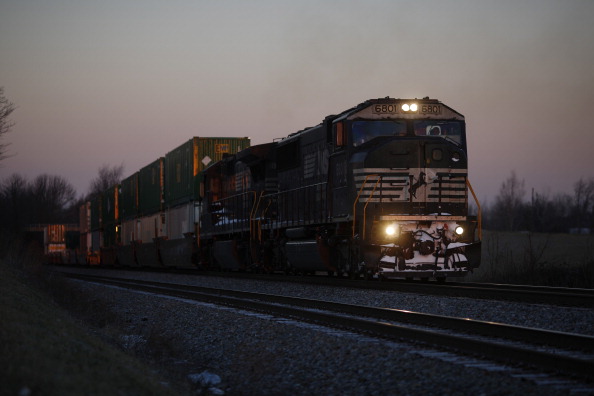Amid the continuing public discussion over improving the safety of crude oil delivered by rail, it’s important that everyone – the energy industry, railroads, regulators, policymakers – stay focused on the facts and the science. This is key to making meaningful improvements to freight rail transportation – which already delivers 99.998 percent of materials like crude oil without incident. We say meaningful improvements because, as with everything we do, the oil and natural gas industry’s safety goal is zero incidents.
First, the science. A new Energy Department report found no data showing correlation between crude oil properties and the likelihood or severity of a fire caused by a train derailment. Also from the report:
No single parameter defines the degree of flammability of a fuel; rather, multiple parameters are relevant. While a fuel with a lower flashpoint, wider range of flammability limits, lower auto-ignition temperature, lower minimum ignition energy, and higher maximum burning velocity is generally considered more flammable, the energy generated from an accident has the potential to greatly exceed the flammability impact of these and any other crude oil property based criteria.
That last point highlights the importance of preventing derailments in the first place because, according to the department’s report, the kinetic energy created by a derailment can play a bigger role in the size of a fire than the commodity the train is hauling. The department’s findings on crude oil properties also are consistent with a Federal Railroad Administration report from last fall, which compared crude oil with denatured alcohol, another hazardous liquid transported by rail. The report cautioned against zeroing in on a single measurement in the quest for safety improvement:
The data suggests that denatured alcohol may pose a greater risk of explosion than crude oil. As such, using vapor pressure as a metric to identify potential hazards may not prove effective when considering real world accident conditions involving tank cars loaded with flammable liquids.
The facts on volatility are important because some believe that a single safety measure, a tank car design, will address rail transport safety. As then-PHMSA Administrator Cynthia Quarterman said last year, “Getting a new tank car is not a silver bullet; first we need to prevent derailments.”
The oil and natural gas industry has been leading the way for a comprehensive, holistic approach that includes three main thrusts: prevention, mitigation and response. On prevention, in addition to Quarterman, others agree – including the Brotherhood of Maintenance of Way Employees and the Railway Supply Institute, whose members build and own the majority of U.S. tank cars. Institute President Thomas D. Simpson, in a Wall Street Journal letter to the editor:
… the focus on accident prevention must forever remain the priority. Forensic data from rail accidents shows that the forces involved are such that in many events even the most aggressive of proposed new tank-car designs wouldn’t have totally eliminated the risk of a commodity release. Reductions in derailment frequency and severity are required to ensure that the billions of dollars to be spent on upgraded tank cars aren’t wasted. Shippers and rail-equipment suppliers don’t control the infrastructure or operating procedures used in transportation. An exclusive focus on tank-car design would represent a missed opportunity for real, fundamental safety improvements.
API President and CEO Jack Gerard underscored the need for a broad rail safety approach during a conference call with reporters that discussed a new first responders education course, developed jointly by the oil and natural gas and railroad industries:
“The oil and natural gas industry is committed to safety; it is our core value in everything we do – exploration, production, refining and transportation. … This is not a goal that can be reached through any single action or step. Eliminating the last elements of risk requires a holistic and science based approach to better prevent, mitigate and respond to derailments of trains carrying crude oil.”
Gerard said first-responder training, which will be taught for the first time this weekend at a firefighters’ conference in Nebraska by instructors from BNSF and at the annual conference for short line railroads in Florida is an example of industry advancing safety and preparedness:
“What we’re doing as industry is we’re moving ahead to make sure we give those local communities and others what they need to understand, in preparation for a response if we have an unfortunate incident. We’re not waiting around for a review to determine that. We believe we can further augment their existing training activities with this educational module. We’re stepping out.”
Gerard said industry has been and will remain engaged:
“We’ve done comprehensive looks at the characteristics of the product we’re moving, we’ve already gotten together with an ANSII-approved process, an accredited process … we’ve developed that system and we’ve already done characteristics of crude with the best minds in the industry, the best regulators – PHMSA participated in that – that was all led by the industry. That was all led by API. In addition to that we’ve come out with enhanced changes to tank car design. We have put all of those forward as well: new pressure relief valves, full head shields, jackets, thermal blankets. We’ve gone forward with regulators and put those proposals forward, showing that we’re not only committed to this, but we believe it could further enhance safety. … I think our industry is very much engaged in this process. We’re leaders in improving in safety. We’re committed to safety, with zero incidents (as the goal).”
By Mark Green
Originally posted March 25, 2015
Energy Tomorrow is brought to you by the American Petroleum Institute (API), which is the only national trade association that represents all aspects of America’s oil and natural gas industry. Our more than 500 corporate members, from the largest major oil company to the smallest of independents, come from all segments of the industry. They are producers, refiners, suppliers, pipeline operators and marine transporters, as well as service and supply companies that support all segments of the industry.

